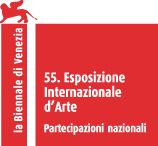i, architecture biennale
Recycling The Japan Pavilion

year: 2012-2013
form: recycle / installation / document photograph
credits:
title of the show: “Architecture. Possible here? Home-for-All”
venue: The Japan Pavilion at the 13th International Architecture Exhibition - La Biennale di Venezia, 2012
date: August 29 – November 25, 2012
organizer: The Japan Foundation
commissioner: Toyo Ito
exhibitors: Kumiko Inui, Sou Fujimoto, Akihisa Hirata (Architects), Naoya Hatakeyama (Photographer)
artist’s notes:
The Architecture Biennale at Venice was initially held on an irregular basis, moving to a biannual format in 1980, and held every two years since then. Like the Art Biennale, countries put together exhibitions for national pavilions, with Japan also taking part, at the Japan Pavilion. This means that for over thirty years now, art and architecture biennales have been held continuously at each national pavilion, alternating years. Over this period however, art and architecture exhibitions of the same theme have never been held at the Japan Pavilion.
For the thirteenth Architecture Biennale (2012), with Toyo Ito as commissioner, and a theme of “Architecture. Possible here?” the Japan Pavilion focused on Japan post March 2011, courtesy of a team of three architects: Kumiko Inui, Sou Fujimoto and Akihisa Hirata, joined by photographer Naoya Hatakeyama, erecting a building as part of Ito's ongoing “Home-for-all” project in the city of Rikuzentakata (one of the areas worst hit by the earthquake and tsunami) and displaying the related documentation. Exhibited at the pavilion, amid salt-damaged logs from the tsunami dotted around, forest-like, were a cluster of architectural models showing the interplay of multiple ideas, interviews with participants, and enclosing the exhibition, photographs by Hatakeyama showing a 360-degree view of the Rikuzentakata landscape. I think their aim at the Architecture Biennale was to engage directly with the affected area, and precisely because they saw for themselves the devastation to buildings caused by the quake and tsunami, to ask the fundamental question of whether it would be possible to rebuild on this now-virgin ground.
What I will attempt to carry out at the Japan Pavilion of the Art Biennale are a few projects that in comparison, will lack in practicality and efficacy. Opaque in objective, ambiguous, in a sense they may be fragile. The thing is, in my view art and architecture may be able to consider some common issues arising out of the experience of an unprecedented disaster. Which is why I decided to try physically leaving things that could be retained from the Japan Pavilion at the 2012 Architecture Biennale, for the Art Biennale in 2013.
アーティストノート:
ヴェネチアでの建築ビエンナーレは、はじめ不定期に行われ、1980年からビエンナーレ方式になり、その後は2年に一度開催されている。国別のパヴィリオンは美術ビエンナーレと同じく各国が展示を企画し、日本も日本館を会場としてきた。各国のパヴィリオンでは、美術と建築のそれぞれのビエンナーレが30年以上も毎年入れ替わりながらつづけられてきたことになる。しかしこの間、日本館において、同じテーマで美術展と建築展が開催されたことはない。
第13回建築ビエンナーレ(2012年)の日本館は、コミッショナーに伊東豊雄を迎え、「ここに、建築は、可能か」というテーマのもと、三名の建築家、乾久美子、藤本壮介、平田晃久に写真家の畠山直哉を加えたチームが3.11以後の日本をテーマとした。地震/津波の被害がひどかった陸前高田に、伊東がつづけてきた「みんなの家」プロジェクトのひとつとして建物を建て、そのドキュメンテーションを展示するというものであった。津波による塩害にあった丸太が林のように乱立する会場の中に展示されたのは、複数のアイデアが交錯するプロセスが見える建築模型群、参加者のインタビュー、そして会場を取り囲むように、陸前高田で撮影された風景を360度捉えた畠山の写真。建築ビエンナーレで彼らが目指したのは、被災地にダイレクトに関わることであり、地震と津波でめちゃくちゃくになった建築を目にしたからこそ、このまっさらになってしまった土地にもういちど建築を建てることは可能かという根本的な問いを立てたのだと思う。
美術ビエンナーレ日本館で、ぼくが行おうとすることは、それに比べれば実用性、実効性の少ないプロジェクトの数々かもしれない。それらは目的が不明確で、曖昧で、ある意味では弱々しいものかもしれない。ただぼくは、建築と美術が、3.11という未曾有の災害の経験からなにかしら共通の問題を考えうるんじゃないかと思っている。だから2012年の建築ビエンナーレ日本館から、維持可能なものを物理的に残し、2013年の美術ビエンナーレ日本館に引き継いでみることにした。







